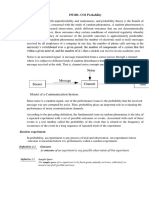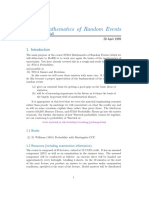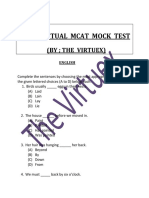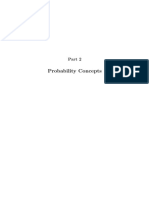Week3 TutorialQuestions
Uploaded by
Herman HermanWeek3 TutorialQuestions
Uploaded by
Herman HermanModule MIS10090: Data Analysis for Decisions Making
Week 3
Tutorial Questions
Question 1: Correlation
Find the (linear) correlation coefficient of the following set of (x,y)=(weight,height) values (55,155),
(60,168), (62,170), (68,172), (70,183):
a) by hand
b) using Excel
How would you interpret the value you get for the correlation coefficient?
Question 2: Correlation
During the Second World War the US Air Force analysed bombing accuracy. The influential
statistician John W. Tukey (who later invented the Fast Fourier Transform) examined a puzzling high
positive correlation between (a) the number of enemy fighter planes present and (b) the accuracy of
the bombing. That is, the more enemy fighters sent up to distract and shoot down the bombers, the
more accurate the bombing run! But how could bombing be more accurate when enemy fighters
were harrying the bombers?
What conclusion do you think Tukey reached? Hint: correlation is not causation!
Question 3: Probability rules
Let us consider two events E and F:
E = {obtaining a final grade for MIS10090 that is greater than A-}
F = {obtaining a final grade for MIS10090 that is less or equal than B-}
Assuming that P(E) = 0.27 and P(F) = 0.62, Please answer the following questions:
a) Are E and F mutually exclusive events (i.e., if one occurs, the other cannot)?
b) What is the probability of the event (E and F)?
c) What is the probability of the event (E or F)?
d) Let us consider now G to be the event {obtaining a final grade for MIS10090 that is greater
than A}. Suppose that P(G) = 0.16. Are E and G mutually exclusive events?
You might also like
- Questions, Numerical Problems, Examples (Part-1)No ratings yetQuestions, Numerical Problems, Examples (Part-1)32 pages
- Physical Science Level K Course Questions Amended 2No ratings yetPhysical Science Level K Course Questions Amended 234 pages
- BA BSC - HONS - ECONOMICS - Sem 3 - CC 7 0204100% (2)BA BSC - HONS - ECONOMICS - Sem 3 - CC 7 02043 pages
- Bachelor of Science (B.SC.) Semester-I Examination STATISTICS (Probability Theory) Optional Paper-1No ratings yetBachelor of Science (B.SC.) Semester-I Examination STATISTICS (Probability Theory) Optional Paper-14 pages
- 19U401-CO1 Probability: Random ExperimentNo ratings yet19U401-CO1 Probability: Random Experiment13 pages
- University of The Philippines College of Science: Name Section Student Number Set ANo ratings yetUniversity of The Philippines College of Science: Name Section Student Number Set A10 pages
- 8B.Sc., Sem.-I CC-3 – Paper-101 StatisticsNo ratings yet8B.Sc., Sem.-I CC-3 – Paper-101 Statistics2 pages
- Class Profileget Resourcelj7clh6fpwk16wlk96gj1eppb6qiNo ratings yetClass Profileget Resourcelj7clh6fpwk16wlk96gj1eppb6qi4 pages
- In-Class Problems Week 15, Fri.: Massachusetts Institute of Technology 6.042J/18.062J, Spring '18 Dr. Zachary AbelNo ratings yetIn-Class Problems Week 15, Fri.: Massachusetts Institute of Technology 6.042J/18.062J, Spring '18 Dr. Zachary Abel3 pages
- Physics: - If A Ball Is Thrown Vertically Upwards With 40 M/S, Then Its VelocityNo ratings yetPhysics: - If A Ball Is Thrown Vertically Upwards With 40 M/S, Then Its Velocity3 pages
- Allama Iqbal Open University Islamabad: WarningNo ratings yetAllama Iqbal Open University Islamabad: Warning5 pages
- On The Behaviour of Potentiating Complex Numbers To INo ratings yetOn The Behaviour of Potentiating Complex Numbers To I2 pages
- Success Study Circle: A Unit of Mili Group Phy-Chem-Math-Bio/It Fm-100 Time-3Hrs PHYNo ratings yetSuccess Study Circle: A Unit of Mili Group Phy-Chem-Math-Bio/It Fm-100 Time-3Hrs PHY1 page
- IEOR 6711: Stochastic Models I First Midterm Exam, Chapters 1-2, October 7, 2008No ratings yetIEOR 6711: Stochastic Models I First Midterm Exam, Chapters 1-2, October 7, 20083 pages
- Maths Class Ix Chapter 05 Introduction To Euclids Geometry Practice Paper 06 AnswersNo ratings yetMaths Class Ix Chapter 05 Introduction To Euclids Geometry Practice Paper 06 Answers7 pages
- PH 205: Mathematical Methods of Physics: Problem Set 1No ratings yetPH 205: Mathematical Methods of Physics: Problem Set 11 page
- Self Assessment Answers 7 Asal Physics CBNo ratings yetSelf Assessment Answers 7 Asal Physics CB2 pages
- November 2020 Confidential Instructions Paper 33No ratings yetNovember 2020 Confidential Instructions Paper 338 pages
- Cambridge International AS & A Level: Physics 9702/12No ratings yetCambridge International AS & A Level: Physics 9702/1216 pages
- Cambridge International AS & A Level: PHYSICS 9702/33No ratings yetCambridge International AS & A Level: PHYSICS 9702/3312 pages












































































